Why it pays to invest in an Australian handmade knife
Bespoke blades are bringing joy to the prep line. Food industry demand for premium local produce has influenced a shift towards high quality tools and Aussie bladesmiths are carving out a respectable slice of the market for themselves – this year's Sydney Knife Show at Rosehill Gardens on August 5 was attended by record numbers and more than 500 custom blades changed hands.
"There has never ever been a time when knife making has been so popular and that custom knives have been so revered," Knife Show co-organiser Corin Urquhart says.
So what gives local bladesmiths the edge when designing personalised pieces for chefs or discerning enthusiasts?
"The price of handmade, one-off Aussie knives is such good value and the feel and joy of using them is priceless," says Pinbone chef Mike Eggert, who judged the Sydney Knife Show competition with his kitchen partner Jemma Whiteman and Attica's Ben Shewry.
"Lots of young chefs buy Japanese blades, which are great, but it's important to support small artisan makers."
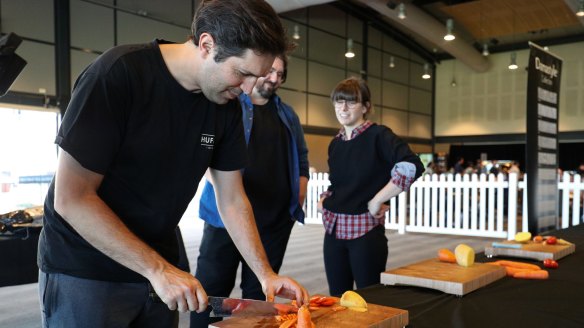
Eggert prefers tough, forged blades that hold their cutting edge. Handmade knives fit the bill, with personalised ergonomics and superior edge retention due to unique heat treatment procedures and steel composition. Chef and knife maker Mert Tansu took home the gong for best kitchen knife at the show.
Tansu says that commercially produced blades are made with "ease of production" in mind rather than cutting performance, comfort or the quality of materials. Blades are often stamped out of sheet steel rather than forged or ground to shape, and softer steels are favoured for easy maintenance. Eggert says that factory-made knives are "great for the house or bashing and crashing jobs" but they aren't as well made and won't have the longevity of an artisanal knife.
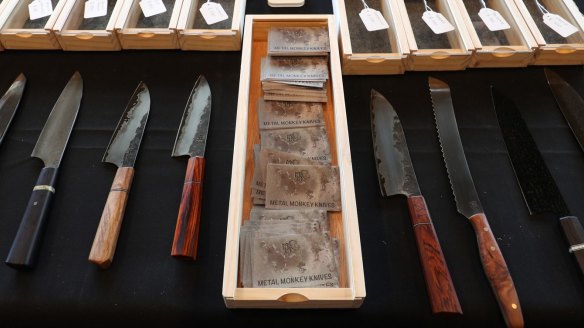
Urquhart likens the difference between commercially produced and artisanal knives to eating at a fast-food joint compared to a great restaurant.
"Sure, you can have an edible meal at a chain restaurant, but there really is no comparison between the two for anyone who has tried both."
Crafting a high-quality blade starts with selecting the right materials. Steel is the essence of the blade and the most important decision to make. Different steels are suited to various applications. Hardness, toughness, edge retention, corrosion and wear resistance are all factors that need to be considered.
While toughness is paramount for a hard-working utility chopper, extreme sharpness is necessary on the sashimi station.In many cases, one steel doesn't cut it. Which brings us to the world of Damascus steel, used to make those achingly beautiful knives known for ornate, multilayered blades that resemble flowing water.
The name comes from the Syrian city where famous swords were produced, revered for their beauty, strength and sharp cutting edge. The distinct patterning is achieved by layers of different steels forge-welded together and folded multiple times. Damascus blades are outmatched by many exotic steel alloys these days, but damn they're sexy.
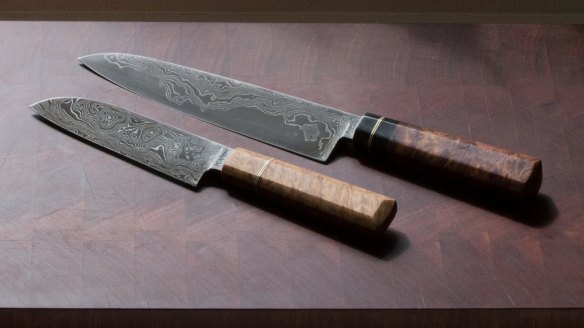
Rather than the cookie-cutter approach favoured in commercial knife production, handmade blades are initially shaped either by stock removal (cutting or grinding away excess steel from a knife "blank") or good old-fashioned forging with hammer, tongs, furnace and anvil – a timeless ode to the craft.
Hand forging allows for multisteel compositions like the pattern weld method mentioned above or the Japanese technique of sanmai, where a softer and more forgiving "jacket" steel is forge-welded to a very hard core.
The knife maker then brings the design to life after many hours on the belt grinder, obsessively measuring, weighing and inspecting. Heat treating is one of the final steps and can make or break a blade, literally. Precise heating followed by quenching and tempering brings the steel to a hardened state – hard enough to hold its edge, but soft and flexible enough not to break under force. Tempering reduces brittleness.
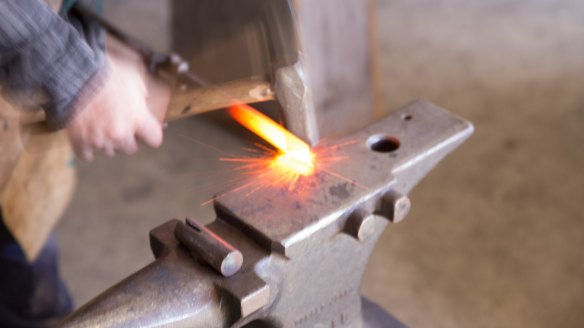
"The heart of the blade is the heat treating, and most custom knife makers pay particular attention to getting this right," Urquhart says. "It's about generating the optimum compromise between the ability to hold an edge and the ease of sharpening."Like a performance vehicle, high-end blades require maintenance and respect. Just like you wouldn't paddock bash a Porsche, it's best to refrain from sawing through tin cans and old shoes (a la Miracle Blade) with your custom sujihiki.
Regular maintenance is paramount, and that doesn't mean using some diamond compound-encrusted multisharpener you picked up at the supermarket. Invest in a proper whetstone. It's also handy to remember that many knife makers offer a lifetime warranty and sharpening, guaranteeing optimum performance and a long life that validates the initial investment.Here are five of the best Australian bladesmiths where you can source your next artisan knife for the kitchen.
Tharwa Valley Forge
Karim Haddad heads up Tharwa Valley Forge alongside a team of bladesmiths and educators including 14-year-old Leila Haddad, whose order books are often busier than her father's. If in need of a testimonial, Ben Shewry is a regular customer.
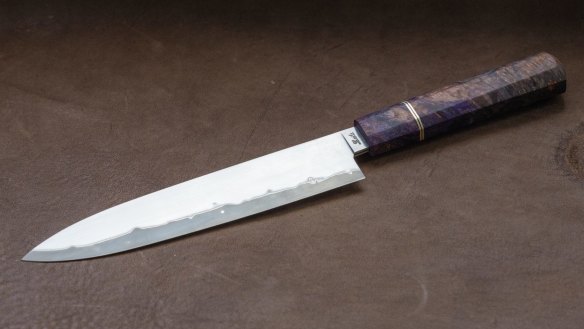
How do I get one? Visit tharwavalleyforge.com to join the waiting list or enrol in a course and make one yourself.
Oatley Knives
James Oatley specialises in single-bevel Japanese-style blades, a far cry from his early days grinding Rambo replicas in the back shed. Style is the key to Oatley's knives, with small creative details setting him apart from the pack. Real talking pieces.
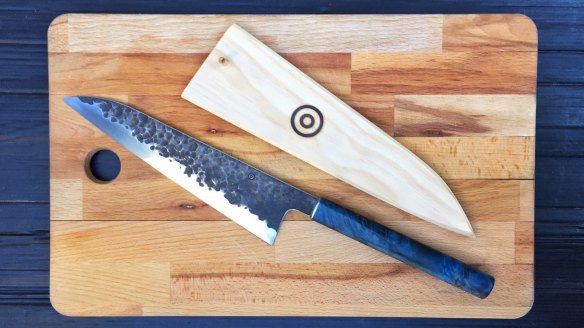
How do I get one? With great difficulty – the books are closed at the moment. Oatley recommends keeping an eye on the @oatleyknives Instagram account.
Mert Tansu Knives
With more than a decade's experience in the kitchen, and currently running shop at Harvest Restaurant in the Hunter Valley, Turkish-born Tansu has broken in his fair share of blades. In 2014 he started making his own and since then, he's been the one to watch, winning best new knife maker at the 2016 Sydney Knife Show.
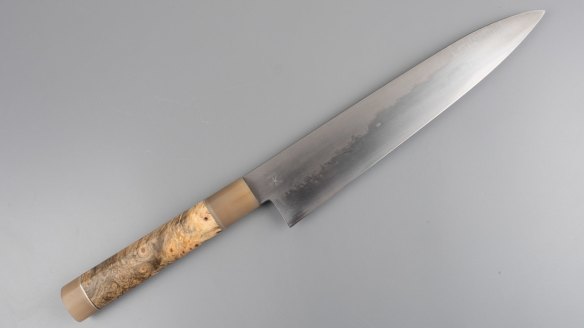
How do I get one? Shop online at knivesandstones.com or email tansuknives@yahoo.com
Metal Monkey Knives
After dabbling in knife restoration, Tobias Bockholt made the leap into hand-forged custom knife making in 2014. He has been kicking goals ever since, coming second at the Sydney Knife Show this year with a Damascus-clad Blue Paper steel number called "the dark one".
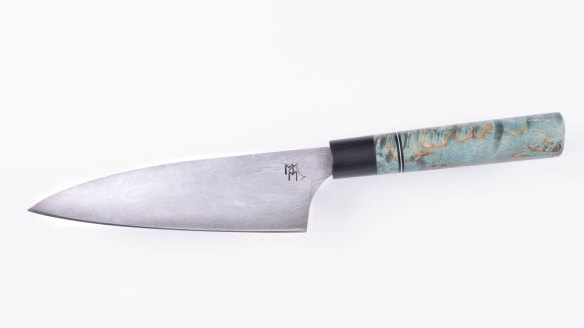
How do I get one? Visit the Metal Monkey Knives Facebook page for a price guide and contact details.
Tristone Blades
With texturally lavish handles almost as ornate as the hypnotically patterned blades, Chadd Smith's pieces are almost too attractive to cut with. He works from a home studio on the Central Coast, specialising in Japanese-style stainless steel blades.
How do I get one? Contact chadd@tristoneblades.com for details.
The best recipes from Australia's leading chefs straight to your inbox.
Sign up